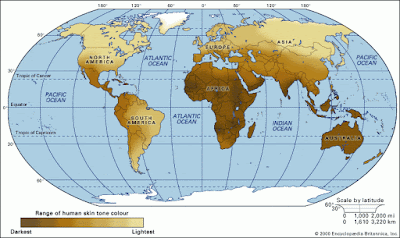Solar radiation is an environmental stress that, in high
levels, has had a major impact on the evolution of hominid specie. Extreme
solar radiation was a major problem to our predecessors in sub-Saharan Africa,
as their skin tone, previously covered by hair or fur, was exposed to the intense
rays of the sun. Darker skin tone, which is determined by the levels of melanin
present in their cells, helps to absorb the harmful UV rays. UV rays, if not
protected against, can cause genetic mutations to skin cells which can lead to
cancer and eventually, death. Additionally, folate, a B vitamin essential to
cell division in embryonic fetal development, is degraded by UV radiation
leading to leading to less reproductive success if affected.
A short term adaptation to solar radiation does not really
exist, as our bodies cannot adjust on the fly
to exposure. This is why
fair-skinned people burn easily, and are more susceptible to skin cancer. An example of a facultative adaptation would be how the skin
tans, and produces more melanin to protect against over-absorption of UV rays,
as h. sapiens migrated away from the
tropics out of the intense UV radiation areas, the dark pigmentation gradually
lightened as the need for high levels of melanin and UV protection diminished.
An example of a facultative adaptation would be how the skin
tans, and produces more melanin to protect against over-absorption of UV rays,
as h. sapiens migrated away from the
tropics out of the intense UV radiation areas, the dark pigmentation gradually
lightened as the need for high levels of melanin and UV protection diminished.
Cultural adaptations to solar radiation can be observed
around us in our everyday lives. Fair skinned people use sunscreen lotion to
form a barrier between their skin and harmful UV rays, along with hats and
umbrellas. As many humans work in offices for a large part of their day, the
need for Vitamin D supplements will continue to increase. Many nutritional
products are fortified with Vitamin D to help meet the recommended daily intake.
The more the scientific community studies genetic adaptations to solar radiation, the better off society will be. If we understand how and why our skin tones are different from our neighbors, we will not see skin tone as a point of differentiation, but, rather, as an indication of equality on our evolutionary tracts. Additionally, the this research can be used for the betterment of society, as new and more advanced treatments and protections against solar radiation can be developed and administered.













